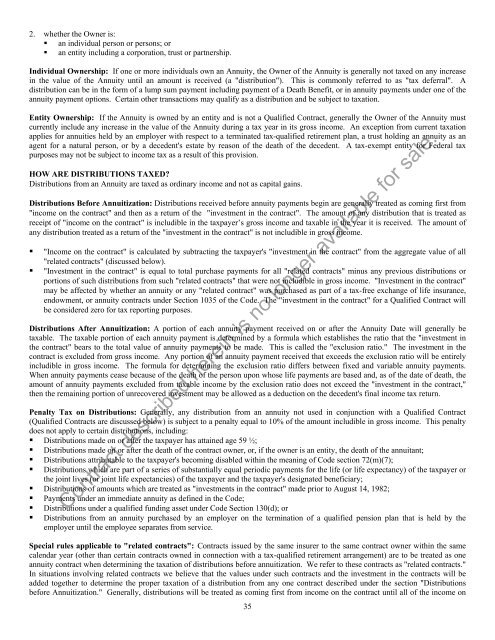Stagecoach Flex - Prudential Annuities
Stagecoach Flex - Prudential Annuities
Stagecoach Flex - Prudential Annuities
You also want an ePaper? Increase the reach of your titles
YUMPU automatically turns print PDFs into web optimized ePapers that Google loves.
2. whether the Owner is:• an individual person or persons; or• an entity including a corporation, trust or partnership.Individual Ownership: If one or more individuals own an Annuity, the Owner of the Annuity is generally not taxed on any increasein the value of the Annuity until an amount is received (a "distribution"). This is commonly referred to as "tax deferral". Adistribution can be in the form of a lump sum payment including payment of a Death Benefit, or in annuity payments under one of theannuity payment options. Certain other transactions may qualify as a distribution and be subject to taxation.Entity Ownership: If the Annuity is owned by an entity and is not a Qualified Contract, generally the Owner of the Annuity mustcurrently include any increase in the value of the Annuity during a tax year in its gross income. An exception from current taxationapplies for annuities held by an employer with respect to a terminated tax-qualified retirement plan, a trust holding an annuity as anagent for a natural person, or by a decedent's estate by reason of the death of the decedent. A tax-exempt entity for Federal taxpurposes may not be subject to income tax as a result of this provision.HOW ARE DISTRIBUTIONS TAXED?Distributions from an Annuity are taxed as ordinary income and not as capital gains.Distributions Before Annuitization: Distributions received before annuity payments begin are generally treated as coming first from"income on the contract" and then as a return of the "investment in the contract". The amount of any distribution that is treated asreceipt of "income on the contract" is includible in the taxpayer’s gross income and taxable in the year it is received. The amount ofany distribution treated as a return of the "investment in the contract" is not includible in gross income.• "Income on the contract" is calculated by subtracting the taxpayer's "investment in the contract" from the aggregate value of all"related contracts" (discussed below).• "Investment in the contract" is equal to total purchase payments for all "related contracts" minus any previous distributions orportions of such distributions from such "related contracts" that were not includible in gross income. "Investment in the contract"may be affected by whether an annuity or any "related contract" was purchased as part of a tax-free exchange of life insurance,endowment, or annuity contracts under Section 1035 of the Code. The "investment in the contract" for a Qualified Contract willbe considered zero for tax reporting purposes.Distributions After Annuitization: A portion of each annuity payment received on or after the Annuity Date will generally betaxable. The taxable portion of each annuity payment is determined by a formula which establishes the ratio that the "investment inthe contract" bears to the total value of annuity payments to be made. This is called the "exclusion ratio." The investment in thecontract is excluded from gross income. Any portion of an annuity payment received that exceeds the exclusion ratio will be entirelyincludible in gross income. The formula for determining the exclusion ratio differs between fixed and variable annuity payments.When annuity payments cease because of the death of the person upon whose life payments are based and, as of the date of death, theamount of annuity payments excluded from taxable income by the exclusion ratio does not exceed the "investment in the contract,"then the remaining portion of unrecovered investment may be allowed as a deduction on the decedent's final income tax return.Penalty Tax on Distributions: Generally, any distribution from an annuity not used in conjunction with a Qualified Contract(Qualified Contracts are discussed below) is subject to a penalty equal to 10% of the amount includible in gross income. This penaltydoes not apply to certain distributions, including:• Distributions made on or after the taxpayer has attained age 59 ½;• Distributions made on or after the death of the contract owner, or, if the owner is an entity, the death of the annuitant;• Distributions attributable to the taxpayer's becoming disabled within the meaning of Code section 72(m)(7);• Distributions which are part of a series of substantially equal periodic payments for the life (or life expectancy) of the taxpayer orthe joint lives (or joint life expectancies) of the taxpayer and the taxpayer's designated beneficiary;• Distributions of amounts which are treated as "investments in the contract" made prior to August 14, 1982;• Payments under an immediate annuity as defined in the Code;• Distributions under a qualified funding asset under Code Section 130(d); or• Distributions from an annuity purchased by an employer on the termination of a qualified pension plan that is held by theemployer until the employee separates from service.Contract described herein is no longer available for sale.Special rules applicable to "related contracts": Contracts issued by the same insurer to the same contract owner within the samecalendar year (other than certain contracts owned in connection with a tax-qualified retirement arrangement) are to be treated as oneannuity contract when determining the taxation of distributions before annuitization. We refer to these contracts as "related contracts."In situations involving related contracts we believe that the values under such contracts and the investment in the contracts will beadded together to determine the proper taxation of a distribution from any one contract described under the section "Distributionsbefore Annuitization." Generally, distributions will be treated as coming first from income on the contract until all of the income on35
















